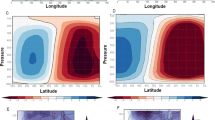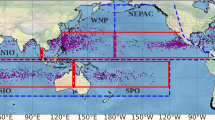Abstract
The NCC T63L20 model of the National Climate Center, China Meteorological Administration is employed to simulate the 1998 summer flood, which mainly occurred in the region of the Yangtze River and Northeast China. For this study, two kinds of cumulus convection parameterized schemes are employed in this model respectively. The simulations show that the Gregory parameterized scheme, which is still used in the United Kingdom Meteorological Office routine model, simulates more reasonable rainfall amount and distribution compared to the Kuo-type scheme. Moreover, the Gregory scheme better simulates the tendency of general circulation than the Kuo-type scheme. On the whole, the Gregory scheme provides a good simulation of the main features of the seasonal precipitation and general circulation in China, although the simulated result still exhibits some departures from the observations.
Similar content being viewed by others
References
Albrecht, B. A., V. Ramanathan, and H. A. Boville, 1986: The effects of cumulus moisture transports on the simulation of climate with a general circulation model. J. Atmos. Sci., 43, 2443–2462.
Arakawa, A., and W. H. Schubert, 1974: Interaction of a cumulus cloud ensemble with the large-scale environment. Part I. J. Atmos. Sci., 31, 674–701.
Bougcault, R. 1985: A simple parameterization of the large scale effects of cumulus convection. Mon. Wea. Rev., 113, 2108–2121.
Gray, W. M., 1973: Cumulus convection and larger scale circulations. J. Atmos. Sci., 41, 5–19.
Gregory, D., and P. R. Rowntree, 1990: A mass flux convection scheme with representation of cloud ensemble characteristics and stability dependent closure. Mon. Wea. Rev., 118, 1483–1506.
Kuo, H. L., 1965: On formation and intensification of tropical cyclones through latent. heat release by cumulus convection. J. Atmos. Sci., 22, 40–03.
Kuo, H. L., 1974: Further studies of the parameterization of the influence of cumulus convection on large-scale flow. J. Atmos. Sci., 31, 1232–1240.
Manabe, S., 1965: Simulated climatology of a general circulation model with a hydrologic cycle. Mon. Wea. Rev., 93, 769–798.
Mintz. Y., and A. Arakuwa, 1965: Northern Ecosystem Initiative Climate Change Bibliography. Technical report about Moscow related studies., 3, 60–66.
Ooyama, K., 1964: A dynamical model for the study of tropical cyclone development. Geofis. Intern., 4, 187–198.
Tiedtke, M., 1989: A comprehensive mass flux scheme for cumulus parameterizationin large-scale models. Mon. Wea. Rev., 117, 1779–1800.
Smagorinsky, J., 1956: On the inclusion of the moist adiabatic processes in numerical prediction models. Berichte Des Deutschen Erttrdicnstes, 38, 82–90.
Author information
Authors and Affiliations
Corresponding author
Rights and permissions
About this article
Cite this article
Ping, F., Gao, S. & Wang, H. A Comparative Study of the Numerical Simulation of the 1998 Summer Flood in China by Two Kinds of Cumulus Convective Parameterized Methods. Adv. Atmos. Sci. 20, 149–157 (2003). https://doi.org/10.1007/BF03342059
Received:
Revised:
Published:
Issue Date:
DOI: https://doi.org/10.1007/BF03342059




